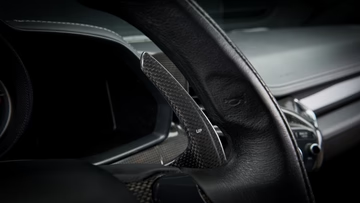Carbon vs Leather Steering Wheels — Which Feels Better Behind the Wheel?

The steering wheel is more than a control device. It is the connection between the driver and the car. Every move you make passes through it. Every feeling on the road comes back through it. Choosing the right material changes everything about driving. Carbon fiber and leather are two of the most popular options. Both feel very different in your hands. Both have advantages.
The Feel of Carbon
Carbon fiber feels firm and precise. It does not flex when you apply force. Every turn goes directly to the tires. You feel the road instantly. Corners, bumps, grip changes, and small corrections are all communicated clearly.
Many drivers describe it as sharp or direct. You do not have to wrestle with the wheel. The car responds instantly. That precision makes carbon ideal for performance driving.
Carbon wheels are also light. This makes steering faster and smoother. Quick lane changes and sharp turns feel effortless. Even during long drives, your arms do not tire as quickly. The combination of lightness and stiffness is what sets carbon apart.
The Feel of Leather
Leather feels soft and warm. It is forgiving and comfortable. Hands sink slightly into the material. The grip feels natural. Leather is excellent for long drives. It absorbs road vibrations. Your hands stay comfortable for hours.
Leather also has drawbacks. It stretches with use. Over time it can lose shape. Heat and moisture can make it sticky in summer or cold in winter.
Feedback and Control
Carbon gives more precise feedback. You can sense grip changes, cornering limits, and road textures. That information helps you drive more confidently. You can react faster and make adjustments instinctively.
Leather gives less feedback. It softens the sensation from the road. That is fine for everyday driving. You rely on intuition more than touch. For performance driving, carbon provides a clear advantage.
Weight and Responsiveness
Carbon fiber steering wheels are lighter. That weight reduction improves steering responsiveness. Every movement feels quicker and more controlled. The wheel feels easier to maneuver.
Leather wheels are heavier. They slightly slow reaction times. Daily driving does not make the difference obvious. On track or spirited driving, lighter wheels feel much more connected.
Lighter carbon wheels also reduce fatigue. Your hands and arms strain less. Comfort and performance work together naturally.
Temperature and Comfort
Leather is warm in cold weather. Carbon fiber remains cooler in hot conditions. High-quality carbon wheels often add Alcantara or leather grips. This gives comfort without losing stiffness.
Leather alone can become uncomfortable. Hot summers make it sticky. Cold mornings make it feel hard. Carbon is more consistent in every condition.
Durability
Carbon fiber is extremely durable. It resists heat, pressure, and wear. It does not lose shape over time. Even under heavy use, it maintains performance and appearance.
Leather is less durable. It can crack, stretch, or fade. It requires regular maintenance. For drivers who push their cars or track them, carbon maintains its quality with minimal effort.
Style and Interior Impact
Leather feels classic and luxurious. It adds warmth to a cabin. Carbon looks modern and technical. Its weave gives a performance-oriented look without any extra decoration.
Both materials can be customized. Leather can have colored stitching. Carbon can mix with Alcantara or painted trims. The choice depends on whether you want comfort or sportiness to dominate the interior feel.
Cost Considerations
Carbon is usually more expensive. That is because of material and manufacturing costs. Its benefits justify the price for drivers who want precision, durability, and responsiveness.
Leather is more affordable. It offers comfort and style without a high cost. For daily drivers, leather is often sufficient.
Personal Preference
The choice comes down to what you value. For precision, feedback, and performance, carbon is better. For comfort, warmth, and tradition, leather works well.
Some drivers combine the two. Carbon provides structure. Leather or Alcantara wraps the grip areas. This balances performance with comfort.
Driving Experience
Carbon changes how you drive. Every turn is intentional. Reactions are faster. Confidence increases. Leather changes how you feel. It makes driving smooth and relaxed. Long trips feel easy.
Neither material is wrong. The right choice depends on driving style, car type, and personal money preference.
Final Thoughts
Carbon fiber and leather deliver very different experiences. Carbon is about precision, responsiveness, and feedback. Leather is about comfort, warmth, and classic feel.
For drivers who push their cars and value connection, carbon transforms the experience. For drivers who prioritize comfort and everyday usability, leather remains attractive.
Knowing the differences helps you make a choice that improves not only the look but the feel of every drive. The right steering wheel ensures your hands and the car speak the same language.

Source: Carbon vs Leather Steering Wheels — Which Feels Better Behind the Wheel?




